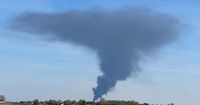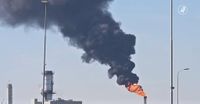On April 8, 2025, a significant incident unfolded at the Shell facility located in Moerdijk, Netherlands, as a large plume of black smoke became visible across the region. The situation, which began with reports of a fire, was later attributed to a power outage that disrupted safety processes at the industrial site.
The first alerts regarding the smoke were received around 1:45 PM, prompting a swift response from local emergency services. According to the Veiligheidsregio Midden- en West-Brabant (MWB), the smoke was described as "significant and increasingly black," raising immediate concerns about a potential fire outbreak. Initial assumptions led many to believe that a fire was indeed raging at the Shell site.
However, it was soon determined that the smoke resulted from an operational safety measure known as flaring, which activates when power failures occur in factories. This mechanism is designed to prevent hazardous situations by burning off excess gas safely. The power outage at the Moerdijk industrial estate was caused by a malfunction at network operator Tennet, which resulted in a temporary halt to normal flaring processes. This interruption led to the large smoke cloud that was visible over a wide area, reminiscent of previous industrial incidents in the region.
As the situation developed, the fire department mobilized a substantial number of fire trucks and personnel to monitor the incident closely. The response was significant enough to warrant a brief escalation to GRIP-1 status, which indicates that an incident requires coordinated efforts from multiple emergency services. Reports noted that the emergency services received the initial call about the incident around 2:00 PM.
By approximately 2:45 PM, the MWB reported that the situation was under control. The normal flaring production process had resumed, leading to a reduction in both the flames and the smoke. A spokesperson for Shell explained that the flaring is a precautionary measure: "The power was out, and then extra flaring is immediately activated. This is done out of precaution." The spokesperson further noted that while the situation was stable, the flaring could continue for up to 24 hours, meaning that residents might still see smoke and an orange glow in the evening and night hours.
This incident drew immediate attention from the local community, with many residents recalling a major fire that occurred in Moerdijk in 2011. That fire, which began at the Chemiepack facility, escalated into a significant disaster, leading to widespread evacuations and safety concerns. The memories of that event were fresh for many as they witnessed the smoke rising from the Shell site.
The MWB reassured the public that despite the visible smoke, there was no immediate danger to the surrounding areas. They emphasized that the situation was being closely monitored and that safety protocols were being followed. Residents in nearby regions, including Hoekse Waard, reported seeing soot particles falling as a result of the smoke, but officials maintained that the flaring process was a controlled response to the power failure.
As the afternoon progressed, the visibility of the smoke began to diminish, and the fire department continued to keep a watchful eye on the operations at Shell. The authorities reiterated their commitment to ensuring the safety of the community and the environment. They also reminded residents that such operational procedures, while necessary, can sometimes lead to temporary disturbances like the one experienced on April 8.
In the wake of the incident, Shell is expected to conduct a thorough review of the events that led to the power outage and the subsequent flaring. The company aims to ensure that all safety measures are adequately prepared for future occurrences, reinforcing their commitment to operational safety and environmental responsibility.
This incident at the Shell facility serves as a reminder of the complexities and challenges that come with operating large industrial sites. While the immediate situation was resolved without any injuries or significant damage, it highlights the importance of robust emergency response systems and the need for ongoing vigilance in industrial safety practices.
As the community of Moerdijk reflects on the events of April 8, the focus will undoubtedly turn towards ensuring that such incidents are managed effectively in the future, safeguarding both the environment and the health of local residents.








